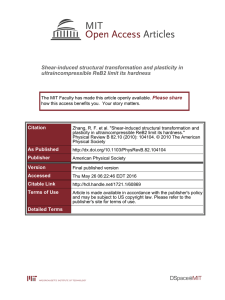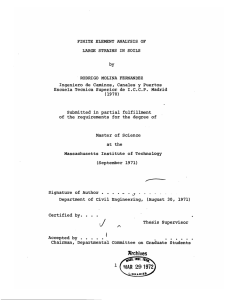Maximum shear stress • Recall • In principal system • Assume
advertisement
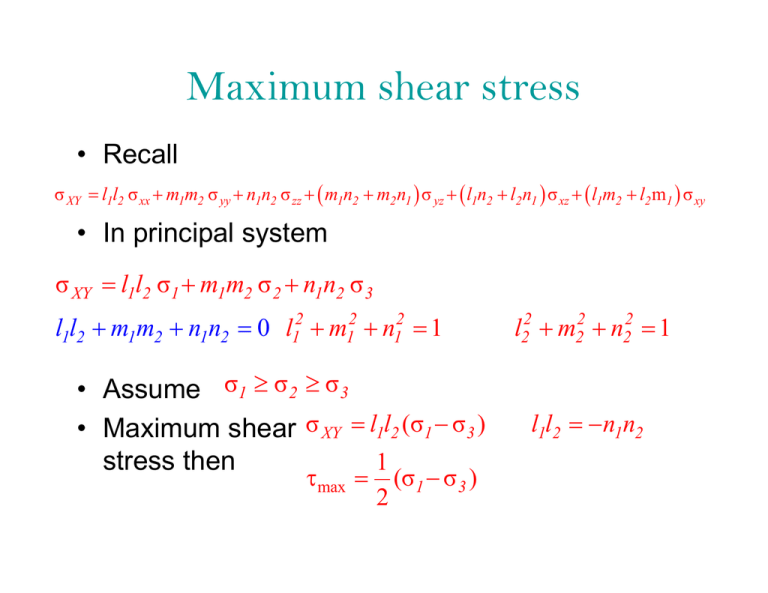
Maximum shear stress • Recall σ XY = l1l2 σ xx + m1m2 σ yy + n1n2 σ zz + ( m1n2 + m2 n1 ) σ yz + ( l1n2 + l2 n1 ) σ xz + ( l1m2 + l2 m1 ) σ xy • In principal system σ XY = l1l2 σ1 + m1m2 σ 2 + n1n2 σ 3 l1l2 + m1m2 + n1n2 = 0 l12 + m12 + n12 = 1 • Assume σ1 ≥ σ 2 ≥ σ 3 • Maximum shear σ XY = l1l2 (σ1 − σ 3 ) stress then 1 τmax = 2 (σ1 − σ 3 ) l22 + m22 + n22 = 1 l1l2 = − n1n2 Example s=1 1 0 1 1 1 0 1 1 >> [l,sig]=eig(s) sig =-0.4142 0 0 0 1.0000 0 0 0 2.4142 Maximum shear stress is 1.4142. Why is this reasonable? Equilibrium when stresses vary from point to point • Differential element Differential equilibrium equations • From equilibrium of infinitesimal element ∂ σ xx ∂ σ xy ∂ σ xz + + + bx = 0 ∂x ∂y ∂z ∂ σ xy ∂ σ yy ∂ σ yz + + + by = 0 ∂x ∂y ∂z ∂ σ xz ∂ σ yz ∂ σ zz + + + bz = 0 ∂x ∂y ∂z bx , by , bz : body force per unit volume in x,y,z directions • Why do we have derivatives of stresses but not of body forces? Equations of equilibrium repair damage done by kinematic assumptions • Most commonly used theories start with assumptions on displacements • Stresses calculated from displacements often do not satisfy equilibrium • Repair via equilibrium equations improves accuracy • Stress post-processing in finite element software is possible and desirable • Check equations in spherical and cylindrical coordinate systems in textbook Beam theory • Euler-Bernoulli beam assumptions mean no shear strains • Equations of equilbrium require shear stresses! • Cantilever beam under end load P My Pxy = I I ∂ σ xx ∂ σ xy + =0 ∂x ∂y σ xx = ⇒ ∂ σ xy ∂y =− Py I Deformation of a deformable body • Deformation will cause a particle P to move from (x,y,z) to (x*,y*,z*) Strain of a line element • Strain measures are typically based on what happens to an infinitesimal line element or to angle between to such elements Displacements • Components of motion u = x* − x ⇒ displacement in x-direction x* = x + u v = y* − y ⇒ displacement in y-direction y* = y + v w = z* − z ⇒ displacement in z-direction z* = z + w • What is the difference between displacements and deformations? Strain measures 2 2 2 2 • Length of infinitesimal ds = dx + dy + dz ( ) [ ] ( ) ( ) 2 2 2 2 element before and ds * = dx * + dy * + dz * ( ) ( ) ( ) ( ) after deformation ds * − ds • Engineering strain εE = ds • Maginfication factor of a line with direction cosines (l,m,n) • What does this remind you of? ⎡⎛ ds * ⎞ 2 ⎤ 1 2 ε εE M = 0.5 ⎢⎜ 1 − = + ⎥ E ⎟ 2 ⎢⎣⎝ ds ⎠ ⎥⎦ ⎡ε xx ε xy ε xz ⎤ ⎧ l ⎫ ⎢ ⎥⎪ ⎪ = [l m n ] ⎢ε xy ε yy ε yz ⎥ ⎨m ⎬ ⎢ε xz ε yz ε zz ⎥ ⎪⎩ n ⎭⎪ ⎣ ⎦ Strain components . Reading assignment Sections 2.7-8: Question: Why do we have two kinds of shear strain? Source: www.library.veryhelpful.co.uk/ Page11.htm



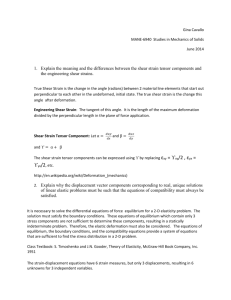

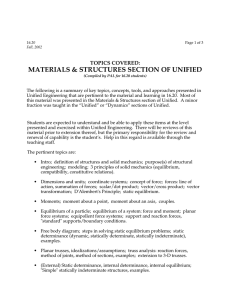

![Applied Strength of Materials [Opens in New Window]](http://s3.studylib.net/store/data/009007576_1-1087675879e3bc9d4b7f82c1627d321d-300x300.png)
